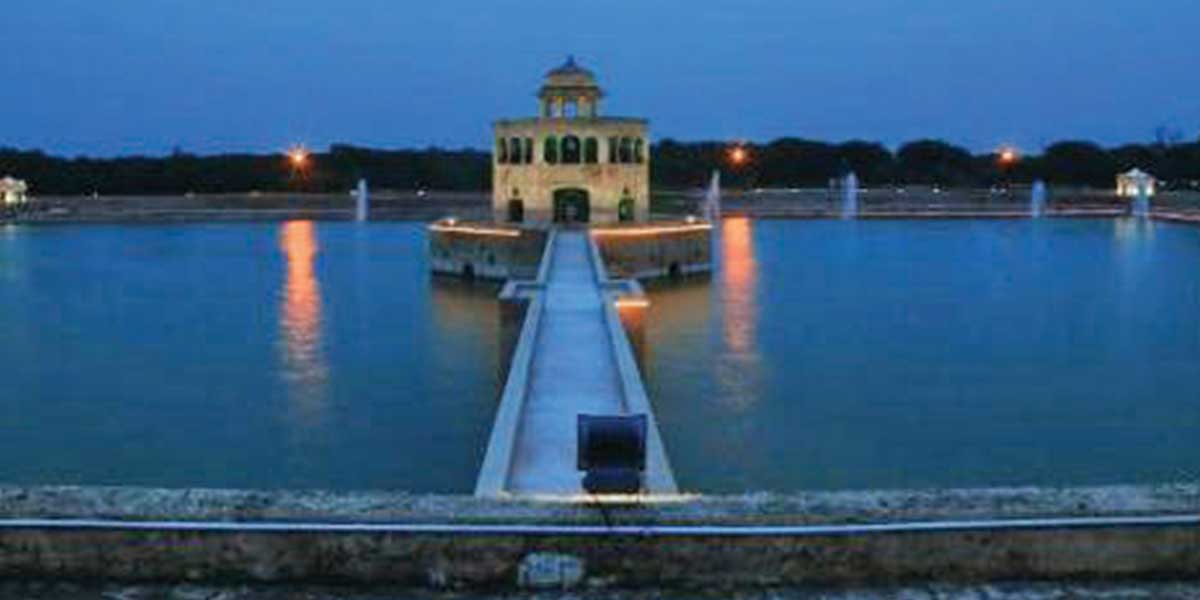Synopsis
Hiran Minar is a symbol of love for pet

One sees, and even hears about various buildings built in the memory of love, but much to the surprise of many, a story about a monument that was built by an emperor in memory of his beloved deer.
The unique example of affection between a human and an animal is one of its kind. The picturesque monument, built by the Mughal Emperor Jahangir in remembrance of his beloved deer, is known as the Hiran Minar.
The piece of art looks like a place from the world of ideas and imagination but the magnificent garden exists in reality in the city of Sheikhupura, Punjab.
The city of Shiekhupura was founded by Emperor Jahangir. Jahangir was affectionately called Shiekhu Baba by his mother, and due to this reason, the city was named Shiekhupura.
The Hiran Minar was built in 1606 in the city of Sheikhupura approximately 40 kilometers to the northwest of Lahore. It can be approached through the M 2 Motorway.
The existence of this eye refreshing wonder is a living example of adoration between a human being and a deer. Taj Mahal is recognized as a prime symbol of affection and love between human beings, while the Hiran Minar stands as an emblem of adoration between a king and his pet deer.
The history tells us that most Kings were sensitive towards nature and people close to them, they often used to build beautiful monument in the memory of their departed loved ones, but Hiran Minar in Sheikhupura is unique in nature because it was built in the remembrance of pet deer which Mughal emperor Jahangir adored.
While observing the history of the sub-continent, it can be known that whether it is a matter of justice or war, love and affection or politics, travel and hunting or art, the Mughal displayed their skills and craftsmanship in every field. In the field of construction, the Mughal adopted their own style and blended it with the beauty of local colors. With this charming combination, various masterpieces like the Badshahi Masjid, Shahi Qila, Shalamar Garden, Taj Mahal and Hiran Minar besides many other architectural worders came into existence.
It has been ages since the conclusion of Mughal Empire but their historic edifices still stand with pride. These centuries’ old edifices had stood firm against the natural calamities such as weather, desolation and earthquakes over the course of time, but they are still standing and telling the story of their glorious past. These buildings still receive accolades from everyone especially the Hiran Minar which is the only example of its kind in the world. It was praised as the everlasting symbol of love between a human and animal by the British dignitaries and rulers during the British rule in the sub-continent. Shiekhupura was given the status of royal hunting reserve because the area was very lush green and vast. Various species of animals could be found in abundance in the dense forest. Many rulers from the sub-continent used to come here upon the invitation of Jahangir for hunting. The hunting reserve was built in dense forest by the Mughal royals with an idea to enjoy adventure of wilderness near Lahore. The feral reserve served as a park where the Mughals and their invited guests could enjoy pleasure of hunting.
It said that Jahangir had a deer named Mansraj (lord of all animal). Jahangir found this antelope in the wilderness while hunting in his favourite hunting reserve in 1606. The animal showed immediate love, sitting at Jahangir’s feet, as if begging for adoption. Jahangir liked this gesture and named it Mansraj and ordered it to be included among the royal animals. Within months, the antelope overcame the wild traits and adopted the pet-like habits.
This is mentioned in the Jahangir’s autobiography “Tuzk Jahangir”. Jahangir stated, “In the month of Zilhaj, on a Tuesday encamped at Jahangirpura which was my favourite hunting reserve, there is a grave of Mansraj and a tower was built in its memory upon my orders, this antelope used to provide amazing assistance to hunt down the wild deer of the forest. In 1607 ‘Mansraj’ died due to illness. Jahangir was deeply saddened over the sudden passing of Mansraj and mourned the death for many days. He ordered the construction of a minaret on the grave of his favorite pet. His chief architect took special interest in the construction of the minaret and the tombstone was put in place which was in the shape of a deer.
The iconic Hiran Minar was built at a high platform. There is a lake in front of it, in middle of which, there is a ‘Baradari’ located. The minaret is 95 feet high, and was erected in 1607 to mark the tomb of the emperor’s beloved deer. The sides of the tower are engraved with the definition of pet deer. It is a huge, and high brick four-storey tower that is missing except for the one above. The lowest floor or basement plan is octagonal in shape and is widely paneled. The other three floors are in circular shape.
The availability of light was ensured through small light openings in each portion while there is a small octagonal room on the third floor in which visitors can take moratorium. The upper three floors of the minaret can be entered through a small door provided at regular intervals. To get to the top of the building, one has to climb hundred almost winding and billowing stairs. The stairs are made of limestone. There are traces that the tower was plastered with limestone once. It seems that the main goal of the builder was to achieve height in addition to a monument, so it could also serve as the best observatory column for finding wild deer and other animals. There is beautiful complex in front of this memorial tower in which lies an octagonal shaped beautiful pavilion at the center of the water tank. It was built during the reign of Shah Jahan.
At the center of the complex there is a large rectangular water pool tank. In the middle of each side of the tank, there is a ramp sloping paved with bricks towards the water; giving access to the wild animals to water, which the hunters were looking for desirably. A Mughal style entry portal is located about 275 feet to the east of the Hiran Minar that leads towards the pavilion or ‘Baradari’ which is built in the middle of the water tank.
The iconic ‘Baradari’ is one of the best masterpieces of the Mughal architectural motif. It has beautiful arched door, airy windows and skylights. The Mughal royals used to sit in the beautiful twelve window edifice situated at the center of the rectangular water tank. The air used to cool down by passing through the water before entering into the Baradari. The Mughals used to rest here after taking a break from their hunting. in this refreshing air edifice.
The deer memorial grave tower and the special water collection system are the exceptional features of the monument. There is a small square building at each corner of the tank besides an underground water storage system that supplies water to the tank. The tourists visit the monument in large numbers frequently.
Catch all the Breaking News Event and Latest News Updates on The BOL News
Download The BOL News App to get the Daily News Update & Live News.












 Read the complete story text.
Read the complete story text. Listen to audio of the story.
Listen to audio of the story.